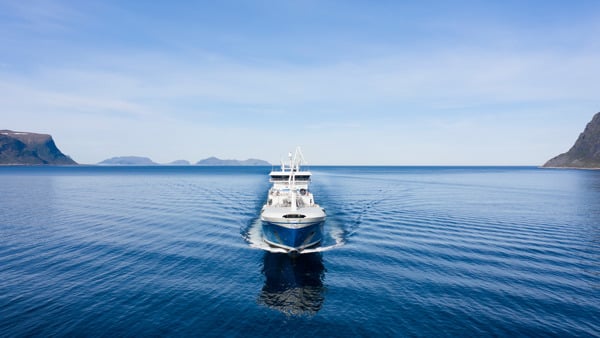How maritime segment is affected by EU regulation
In 2021, the European Commission launched the extensive “Fit for 55” climate package with the aim of reducing the EU’s emissions of greenhouse gases by at least 55% by 2030 compared to 1990 levels.
Consequently, “Fit for 55” includes four proposals that will have an impact on the maritime segment. These measures include FuelEU Maritime, EU Emission trading system (EU ETS), Energy Taxation Directive (ETD) and Alternative Fuel Infrastructure Regulation (AFIR). In addition, the Renewable Energy Directive (RED III) will have an impact on the maritime segment as well. Even though much work remains before the entire package comes through the democratic process, there are several parts that have already been approved by the council and the parliament.
FuelEU Maritime
One of the proposals that will affect the maritime industry is the FuelEU Maritime Regulation which will come into force from 1 January 2025. FuelEU Maritime is a regulation on the use of renewable and low-emission fuels in maritime transport forcing shipping companies to switch to alternative fuels.
The regulation ensures that the greenhouse gas (GHG) intensity of shipping industry will gradually decrease over time. Compared to 2020 levels, the decrease must be 2 % from 2025 onwards, to as much as 80% from 2050 onwards. The reduction target mandates ship owners to reduce the emissions of their fleets, not individual vessels. There will be significant sanctions imposed if a shipping company fails to comply with the emission reduction targets.
The reduction of greenhouse gas intensity by fleets from 2020 levels:
- 2 % from 2025 onwards
- 6% from 2030 onwards
- 14,5 % from 2035 onwards
- 31% from 2040 onwards
- 62% from 2045 onwards
- 80% from 2050 onwards
The regulation is in force 100 % in internal EU routes and in EU ports, and 50 % for routes outside EU member states, regardless of flag.
Shipping companies are allowed to pool the performances of different ships and use the possible over-performance of one ship to compensate for the underperformance of another. Hence the shipping companies can pool the reduction needs of their own vessels but also of vessels of other companies. This way the reductions are made where it is most cost-efficient.
Read more about pooling
Read how the use of liquefied gas can help shipping companies reach their target
EU ETS for Maritime
The new updated EU Emissions Trading System (EU ETS) will include shipping in the system from 2024 onwards. This means that shipping companies will have to purchase and surrender EU ETS emission allowances for each ton of reported CO2 emissions in the scope of the system. The EU ETS is a “cap and trade” system where GHG allowances can be traded on the EU carbon market.
EU ETS will impact the shipping companies gradually, since actors will initially have to surrender allowances for a portion of their emissions during an initial phase-in period, reaching 100% after 3 years:
- 40% of allowances needed of verified emissions reported in 2024
- 70% in 2026 and CH4 and N2O added to EU ETS (for 2025 emissions)
- 100% in 2027
The EU ETS will be applied to all cargo vessels and passenger ships over 5,000 GT (gross tonnage). The scope of emissions trading in internal routes and port calls within EU/EEA is 100 % of emissions and 50 % for voyages starting or ending outside the EU.
Read more about EU ETS for maritime
Energy Taxation Directive (ETD), Alternative Fuel Infrastructure Regulation (AFIR) and Renewable Energy Directive (RED)
The revised Energy Taxation Directive (ETD) aligns taxation of energy products, including maritime fuels, with EU’s climate aims. Maritime bunker fuels, formerly tax-free, will most likely have taxes imposed with the most polluting fuels bearing the highest taxes. The European Parliament has not yet approved, rejected, or amended the proposal.
The Alternative Fuels Infrastructure Regulation (AFIR) is aimed at increasing the availability of alternative fuels, like LNG, and environmentally friendly electrical power supplies at the ports within the EU. While it doesn’t directly impact ship operators, it aids them in meeting their FuelEU mandates by improving alternative fuel infrastructure and encourages investments by removing related barriers and uncertainties.
Revised Renewable Energy Directive (EU RED III) targets a 42.5 % share of renewable energy by 2030 but aims for 45 %. It imposes specific targets on Member States in sectors such as transport, which is required to have a 29% share of renewable energy or a 14.5% reduced GHG intensity by 2030. The revised directive also mandates the use of e-fuels in transportation: minimum 1 % must be of non-biological origin, so called RFNBOs (Renewable Fuels of Non-Biological Origin).

Download our guide - Pioneering cleaner shipping
We have gathered some information for you in a guide about cleaner maritime transports. You will see what influences shipping to reduce emissions, including regulations, market demands and trends.
Contact us for more information

